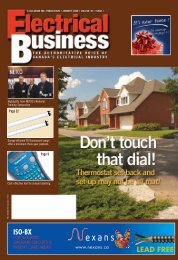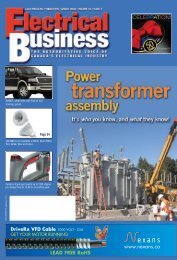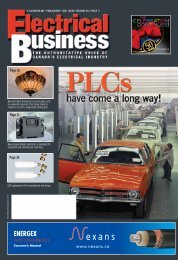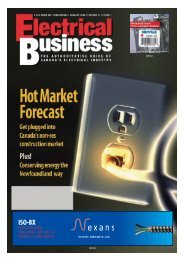Page 27 Page 32 Page 17 - Electrical Business Magazine
Page 27 Page 32 Page 17 - Electrical Business Magazine
Page 27 Page 32 Page 17 - Electrical Business Magazine
- No tags were found...
Create successful ePaper yourself
Turn your PDF publications into a flip-book with our unique Google optimized e-Paper software.
stainless steel hinges, corrosion-resistant handles and otherhardware, and rain shields on cooling air intakes and exhaust.Cooling air intakes and exhaust may need motorized louversthat open when the genset is started and close automaticallywhen it is off to protect against precipitation.The outer surfaces of the enclosure can be primed andpainted sheet metal—either steel or aluminum. The paint needsto be of a quality and thickness to retain gloss and resist minorimpacts and corrosion due to salt spray, humidity and water (inaccordance with appropriate ASTM standards).In areas where ice and snow accumulate, it will be necessaryto provide for regular snow/ice removal around doors, louversand dampers. In cold climates, the enclosure may have to be fittedwith an electric space heater in addition to having a coolantheater on the generator engine. Also, diesel fuel may need to beheated to prevent gelling.In storm-prone areas, consider an enclosure with added structuralstrength to withstand high wind loading. Outdoor generatorenclosures are available with enhanced strength that resists windspeeds of over 150 miles per hour. In earthquake-prone areas, aseismic-certified enclosure may be required. In flood-prone areas,install the generator and enclosure well above the highest expectedwater level (on an elevated platform or a rooftop, for example).Industrial Grade Qualityavailable in Type 1 and Type 3Renclosures for commercial andmulti-residential users.t 30A to 1200A, Fusible orNon-fusible devicest Double throw switches forback-up powerNEW Featuresy Elevator interlocks up to 200Ay Rated for solar powerapplicationsy Optional finger safe protectionControlling temperatureGensets can maintain their rated power output so long as theambient air temperature flowing into the enclosure does notexceed the cooling system ambient temperature rating and staticrestriction. When this air temperature is exceeded, the output ofthe generator will have to be reduced to prevent overheating.Cooling requirements for the enclosed genset can also be affectedby site selection. Whenever possible, locate the enclosure in anarea where there is free air flow. Avoid locations such as coveredparking ramps or other nearby walls or overhangs that may restrictcooling air flow or require complex routing of engine exhaust.Select an enclosure with adequate flow-through ventilationthat keeps temperatures in the optimum operating range. Thiswill allow the generator set to operate at its nameplate rating.The best enclosures incorporate advanced radiator, fan and louverdesigns that provide optimal airflow through the enclosure tocontrol engine and generator operating temperatures even in themost severe environments. Keep cooling air intakes and exhaustsclear of obstacles.SecurityVandalism is a common problem that can compromise a standbypower system’s reliability. Lockable access points to connections,Square DCommercial Safety Switchesswitches and valves deter unauthorized persons frominterfering with system operation. Access to the fueltank and system controls should also be restricted.Sound attenuationAlthough gensets used for standby power do notrun often, controlling the noise they produce canbecome a major concern when they are located nearthe property line or in a crowded urban environment.Most locales have ordinances that set limits onpermissible sound levels at the property line. Whileexhaust silencers can greatly suppress exhaust noise,much of the noise from an enclosed genset comesfrom the cooling air fan. This fan noise is harderto control but can be greatly reduced by carefullydesigning the air intake and air exhaust plenums.Sound attenuation depends on many factors,including the sound level produced by the generatorengine, the design of the air intake/exhaust plenums,the type of exhaust silencer and local conditions.Work with your genset and enclosure supplierto determine the level of noise suppression neededto comply with local regulations. Most enclosureproviders offer one or more levels of sound attenuationas options.Additional issues regarding sound attenuationinclude:• Critical sound-attenuation remedies will increasethe overall footprint, complexity and cost of aninstallation.• Sound-attenuating materials in the walls andceiling of the enclosure trap not only sound,but heat.• If sound attenuation is required, specify nonhygroscopicand non-flammable material to preventmoisture build-up inside the enclosure.• Pay particular attention to noise generated atcooling air intake/exhaust plenums. The designof airflow through the enclosure is critical tominimizing this noise.FuelFor increased security and to reduce the footprint ofyour installation, many gensets can be ordered withan integrated high-capacity fuel tank. It protects fuellines and filler connections within the enclosure forbetter security and provides a compact installation.Look for tanks that include dual-wall construction,fuel gauges and provisions for catching fuel leaks,ruptures and overflows. Be sure to allow sufficientclearance around the enclosure to allow fuel trucksto access the enclosure. Consult local authoritiesregarding fuel tank codes.MaintenanceFor walk-in enclosures, ensure there is sufficient roomwithin for easy maintenance access to key gensetcomponents. Skin-tight enclosures should have largeaccess doors and panels. Good interior and exteriorlighting can make all maintenance and troubleshootingtasks easier.Info no. 21For more information visit,www.schneider-electric.ca/dcConclusions and recommendationsSpecifying the best enclosure for a standby powersystem is an important task, because it can have animpact on both the short-term operation and longtermreliability of the system. Start with a thoroughassessment of your power needs, installation locationand environment, then work with your gensetand enclosure supplier to design an installation thatfits all your specifications.Jim Iverson is a senior applications engineer for CumminsPower Generation, and holds degrees in Engineering Scienceand <strong>Electrical</strong> Engineering. His responsibilities includeproviding technical direction to the Commercial Marketingand Sales departments, participating in domestic industrycodes and standards development, providing sales andservice training, developing technical input for publishedliterature and software, publishing technical papers on relevantindustry topics, and providing application engineeringsupport to customers.Schneider_pg2_EB_Oct07.indd 118 • november/december 2007 • www. mag.com9/24/07 10:26:19 AM
















